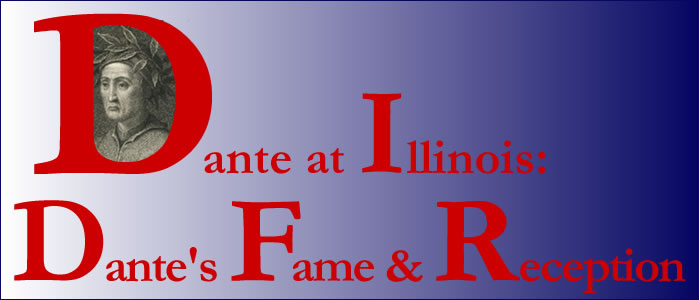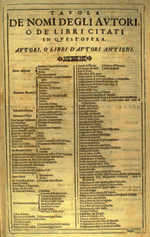15 Bulgarini, Belisario. Risposte di Bellisario Bulgarini a’ Ragionamenti del Sig. Ieronimo Zoppio, intorno alla Commedia di Dante. Replica alla Risposta del medesimo Zoppio, intitolata, Alle oppositioni sanesi &c. Siena: Luca Bonetti, 1586.
In 1583, Girolamo Zoppio (d. 1591) published a treatise on Dante and Petrarch, entitled Ragionamenti del signor Hieronimo Zoppio in difesa di Dante et del Petrarca. Zoppio, like Mazzoni before him, was not immune to the criticisms of Belisario Bulgarini, the Sienese scholar who published this response just three years after his attack on Mazzoni.
Shelf mark: 851D23 OdYzoYb
16 Chaucer, Geoffrey. The Boke of Chaucer Named Caunterbury Tales. Westminster: Wynkyn de Worde, 1498.
The famous medieval English poet Geoffrey Chaucer (d. 1400) was one of the first non–Italian authors to incorporate Dante’s works into his own. In fact, the earliest English translation from Dante appears in Chaucer’s Troilus and Criseyde. The Wife of Bath’s Tale refers to Dante as “the wise poet of Florence,” and loosely translates Purgatorio 7:121-123, in which Sordello (see Item 19) explains that individuals gain nobility through God, not through inheritance:
Well can the wyse poet of florence
That hyght daunte speke of this sentence
Lo in suche manere ryme is dauntis tale
Full selde up ryseth by his braunches smale
Prowesse of man for god of his goodnes
Wyll that of hym we clayme our gentylnes
For of our olders maye we no thynge clayme
But te[m]porall thyng that may hurte [and] mayme (leaf h3r).
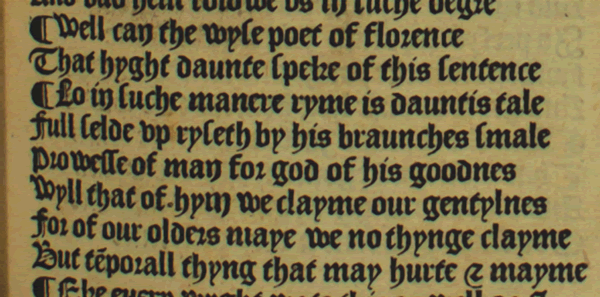
Item 16. leaf h3r. enlarged
[Thus the wise poet of Florence,
Called Dante, speaks on this,
Behold, in rhyme, Dante’s tale:
“Seldom arises through these slender branches
Prowess of men, for it is God, by His goodness,
Wills us to claim from Him our gentleness.”
For we may claim nothing from our elders
Except temporal things that may hurt and maim.]
This edition of the Canterbury Tales is exceedingly rare: only six copies are recorded, some consisting only of a few leaves. The University of Illinois copy contains 113 of the original 153 leaves with the remainder supplied in a nineteenth–century manuscript facsimile from the copy in the British Library.
References: Boswell, 1, 7; Goff C–434; Harman 252; ESTC S108866; Toynbee, 1:1–16
Shelf mark: Incunabula Q.821 C39c 1498
17 Boccaccio, Giovanni. “Fall of Princes.” Manuscript adaptation by John Lydgate of Giovanni Boccaccio’s De casibus virorum illustrium. [England, ca. 1450].
This Middle English manuscript contains John Lydgate’s (ca. 1370–ca. 1450) verse adaptation of Laurent de Premierfait’s (d. 1418) French prose version of Boccaccio’s De casibus virorum illustrium, or, On the Fall of Illustrious Men. Lydgate’s adaptation contains three references to Dante, among the earliest in English after Chaucer. The poem was begun under the patronage of Humphrey, Duke of Gloucester, in the early 1430s and was completed by the end of the decade, remaining a popular text throughout the fifteenth century. In the prologue to the fourth book, shown here, Lydgate ranks Dante with classical authors:
Wryttynge causeth ye chaplet to be grene
Bothe of Esope [and] of Juvenall
Dantis laboure hit doth also maynteene
By a report of veray celestiall
Sunge amonge lumbardis in especiall
Whos thre bookis ye grete woundres telle
of hevene above of purgatorie and helle (p. 191).
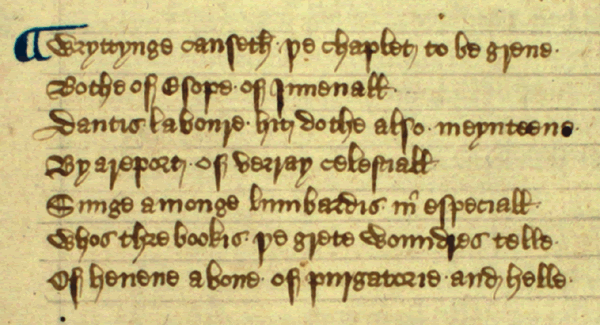
Item 17. p. 191, enlarged
[Writing causes the chaplet to be green
Both of Aesop and of Juvenal;
Dante’s labor it also maintains
By a report very celestial,
Sung among the Lombards especially,
Whose three books the great wonders tell
of heaven above, of purgatory, and of hell.]
This codex was produced by an unknown English scribe around 1450. The text is written on paper in a gothic cursive book hand in two columns per page. Paragraphs are decorated with alternating red and blue initials, and many section headings are pen-flourished. Lydgate’s poem circulated in manuscripts such as this one before the first printed edition appeared in 1494.
References: DNB 34:843–848; Faye & Bond. p. 170, no. 84; Toynbee, 1:18–20
Shelf mark: Pre–1650 MS 84
18 Accademia della Crusca. Vocabolario degli Accademici della Crusca. Venice: Giovanni Alberti, 1612.
The Florentine Accademia della Crusca arose from a group of friends who, after a decade of meetings during the period 1570 to 1580, took upon themselves the great task of compiling a dictionary of what they deemed to be “pure” Italian. Not surprisingly, they chose to base their new lexicon on the works of fourteenth–century Tuscan authors, in particular the “Tre corone,” or “Three Crowns,” Dante, Petrarch, and Boccaccio. In 1595, the Academy presided over the publication of a new scholarly edition of the Divina commedia, produced to provide a text on which to base dictionary entries. The first edition of the dictionary was published in 1612, and Dante appears at the top of the list of authors cited. Dante’s supporters were few in the seventeenth century (see Item 10), and the position of the influential Accademia della Crusca was significant in keeping alive some interest in the poet. More importantly, the Academy’s work helped to establish Dante’s Tuscan dialect as the national language of Italy.
Shelf mark: Q.453 Ac2 1612
19 Dante Alighieri. La Divina commedia. Illustrated by Salvador Dalí. 3 vols. in 6. Rome and Florence: Arti e scienze and Salani, April 1963 – May 1964.
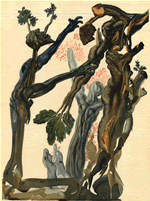
©2006 Salvador Dalí, Gala-Salvador Dali Foundation/Artists Rights Society (ARS), New York Item 19. v. 1, plate 13
Since Dante’s time, artists have attempted to interpret the poet’s works. In the twentieth century, Salvador Dalí (1904-1989) looked at Dante through Surrealist eyes.
A production of Giovanni Mardersteig’s press, the Stamperia Valdonega in Verona, this edition is prized for its illustrations by Dalí. Mardersteig writes, “Every printer must welcome the opportunity to print so towering a work as Dante’s Divina Commedia. . . . I have designed several editions, both in English and Italian, but none fascinated me as this one did.” Dalí’s “eccentric colour illustrations” were engraved and printed by Raymond Jacquet in Paris, and Mardersteig designed the book around them.
Dalí’s interpretation of Inferno 13 is a depiction of Dante’s “Wood of the Suicides,” home to the souls of those who have committed violence against themselves. These sinners will spend eternity as trees, feeling pain as Harpies feast upon their leaves and their limbs are torn off repeatedly by packs of dogs chasing the souls of spendthrifts.
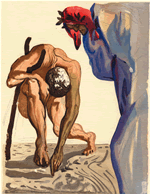
©2006 Salvador Dali, Gala-Salvador Dali Foundation/Artists Rights Society (ARS), New York Item 19. v. 3, plate 7
Dalí’s rendering of Purgatorio 7 portrays Dante and Sordello, a medieval poet whom Dante held in esteem. Sordello is bent over, drawing a line on the ground to emphasize to Dante that he will not be able to travel even as far as the line once the sun sets and darkness falls.
References: Everling; Mardersteig, 133
Shelf mark: Q.851D23 Od.n
20 Mazzoni, Jacopo. Della difesa della Comedia di Dante. Parte prima. Cesena: Bartolomeo Raverio, 1587; Della difesa della Comedia di Dante. Parte seconda posthuma. Cesena: Severo Verdoni, 1688.
In 1572, Jacopo Mazzoni (1548-1598) published a discourse in defense of Dante’s Divina commedia in response to an earlier pseudonymous analysis of the poem which had circulated in manuscript. Mazzoni’s work was reprinted in 1573 under the pseudonym Donato Roffia, and, ten years later, Belisario Bulgarini (ca. 1538-1619) published “some considerations” on Mazzoni’s argument. The first part of Mazzoni’s defense against Bulgarini was published in 1587 by Bartolomeo Raverio. The second part was published posthumously in 1688, along with a reprint of part one, by Severo Verdoni. As a comprehensive poetic and philosophical treatise, the work became a popular embodiment of Italian Renaissance thought in modern times.
References: Mazzoni (1983)
Shelf mark: 851D23 OdYma
21 Giambullari, Pierfrancesco. Lezzioni di M. Pierfrancesco Giambullari, lette nella Accademia fiorentina. Florence: Lorenzo Torrentino, 1551.
This collection of public lectures by the Florentine linguist, historian, and academician Pierfrancesco Giambullari (1495–1555) contains treatises on the Purgatorio and the Paradiso. Like his fellow Florentine academicians, Giambullari was a proponent of the Florentine language of Dante.
Shelf mark: 853G347 K1551
22 Sardi, Alessandro. Discorsi del S. Alessandro Sardo. Venice: Gioliti, 1586.
This volume contains treatises by the Ferrarese philologist and historian, Alessandro Sardi (1530–1588). Among them is his “Discorso della poesia di Dante considerata nello Inferno,” or, “Discourse on the poetry of Dante considered in the Inferno,” in which he argues for the classification of the Divina commedia as an epic poem.
Shelf mark: 853S24 K1586
23 Torelli, Giuseppe. Lettera del Signor Giuseppe Torelli, veronese, sopra Dante Aligeri contro il Sig. di Voltaire. Verona: Heirs of Marco Moroni, 1781.
Voltaire was, according to W. P. Friederich, “the last great enemy of Dante in France” (p. 92). In the 1764 edition of his Dictionnaire philosophique, Voltaire criticizes Dante and describes the Divina commedia as a “bizarre poem.” Previous to that, however, Voltaire had authored a parody of Inferno 27 to which Giuseppe Torelli (1721–1781) wrote the present refutation. Torelli’s Lettera includes a translation into Italian of Voltaire’s parody, followed by his defense of Italy’s poet laureate based on a comparison of this translation with Dante’s original text.
References: Friederich, p. 92–102.
Shelf mark: 851D23 DT64
24 Lenzoni, Carlo. In difesa della lingua fiorentina, et di Dante. Con le regole da far bella et numerosa la prosa. Florence: Lorenzo Torrentino, 1556 [colophon: 1557].
This treatise by Carlo Lenzoni defending Dante and the language of Florence was edited after the author’s death in 1551 by Pierfrancesco Giambullari (see Item 21). After Giambullari’s death, work on the edition was continued by Cosimo Bartoli. Lenzoni was a Florentine scholar, literary critic, and academician whose work seeks to categorize the genre of the Divina commedia and to establish Dante as the model for a uniform Italian language.

